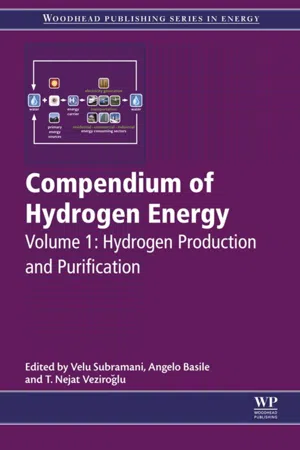
Compendium of Hydrogen Energy
Hydrogen Production and Purification
- 550 pages
- English
- ePUB (mobile friendly)
- Available on iOS & Android
Compendium of Hydrogen Energy
Hydrogen Production and Purification
About this book
Compendium of Hydrogen Energy: Hydrogen Production and Purification, the first text in a four-volume series, focuses on the production of hydrogen. As many experts believe that the hydrogen economy will eventually replace the fossil fuel economy as our primary source of energy, the text provides a timely discussion on this interesting topic.The text details the methods of hydrogen production using fossil fuels, also exploring sustainable extraction methods of hydrogen production from water and hydrogen purification processes.- Provides a comprehensive understanding of the current methods used in the production of hydrogen- Discusses the hydrogen economy and its potential to replace fossil fuels as our primary source of energy- Details the methods of hydrogen production using fossil fuels, also exploring sustainable extraction methods of hydrogen production from water and hydrogen purification processes
Frequently asked questions
- Essential is ideal for learners and professionals who enjoy exploring a wide range of subjects. Access the Essential Library with 800,000+ trusted titles and best-sellers across business, personal growth, and the humanities. Includes unlimited reading time and Standard Read Aloud voice.
- Complete: Perfect for advanced learners and researchers needing full, unrestricted access. Unlock 1.4M+ books across hundreds of subjects, including academic and specialized titles. The Complete Plan also includes advanced features like Premium Read Aloud and Research Assistant.
Please note we cannot support devices running on iOS 13 and Android 7 or earlier. Learn more about using the app.
Information
Introduction to hydrogen and its properties
Abstract
Keywords
Fuel cells; History; Hydrogen; Ortho-hydrogen; Para-hydrogen; Steam reforming; Syngas1.1. Introduction
1.2. Some historical events (Hoffmann, 2012 and hydrogen fact sheet)
| 1766 | Henry Cavendish, the British scientist, first identified hydrogen as a distinct element after observing a gas evolved by the reaction of zinc metal with hydrochloric acid. In a demonstration to the Royal Society of London, Cavendish applied a spark to hydrogen gas that yielded water (H2O). This discovery led to his later finding that H2O is made of hydrogen and oxygen. |
| 1783 | Jacquest Alexander Cesar Charles, a French physicist, launched the first hydrogen balloon flight known as Charliere. This unmanned balloon flew to an altitude of 3 km. Three months later, Charles himself flew in his first manned hydrogen balloon. |
| 1788 | Based on the discoveries of Cavendish, the French chemist Antoine Lavoisier gave hydrogen its name, which was derived from Greek words: “hydro” and “genes,” meaning “water” and “born of.” |
| 1800 | English scientists William Nicholson and Sir Anthony Carlisle discovered the process of “electrolysis.” |
| 1838 | Swiss chemist Christian Friedrich Schoenbein discovered the fuel cell effect that produced electric current and pure water by combining hydrogen and oxygen gases. |
| 1845 | Sir William Grove, an English scientist and judge, demonstrated Schoenbeinʼs discovery on a practical scale by creating a “gas battery.” He earned the title “father of the fuel cell” for his achievement. |
| 1874 | Jules Verne, a French author, prophetically examined the potential use of hydrogen as a fuel in his popular work of fiction entitled The Mysterious Island. |
| 1889 | Ludwig Mond and Charles Langer attempted to build the first fuel cell device using air and industrial coal gas. |
| 1920 | German engineer Rudolf Erren converted the internal combustion engines of trucks, buses, and submarines to use hydrogen or hydrogen mixtures. During this period, British scientist and Marxist writer, J.B.S. Haldane, introduced the concept of renewable hydrogen. |
| 1952 | The United States of America conducted its first nuclear test of a fusion device, or “hydrogen bomb” at Eniwetok in the Marshall Islands. |
| 1958 | The United States formed the National Aeronautics and Space Administration (NASA). NASA's space program currently uses the most liquid hydrogen worldwide, pr... |
Table of contents
- Cover image
- Title page
- Table of Contents
- Related titles
- Copyright
- List of contributors
- Woodhead Publishing Series in Energy
- Part One. Introduction to hydrogen
- Part Two. Conventional hydrogen production methods
- Part Three. Production of hydrogen through electrolysis
- Part Four. Emerging methods for the production of hydrogen
- Part Five. Hydrogen purification and low-carbon hydrogen production
- Index